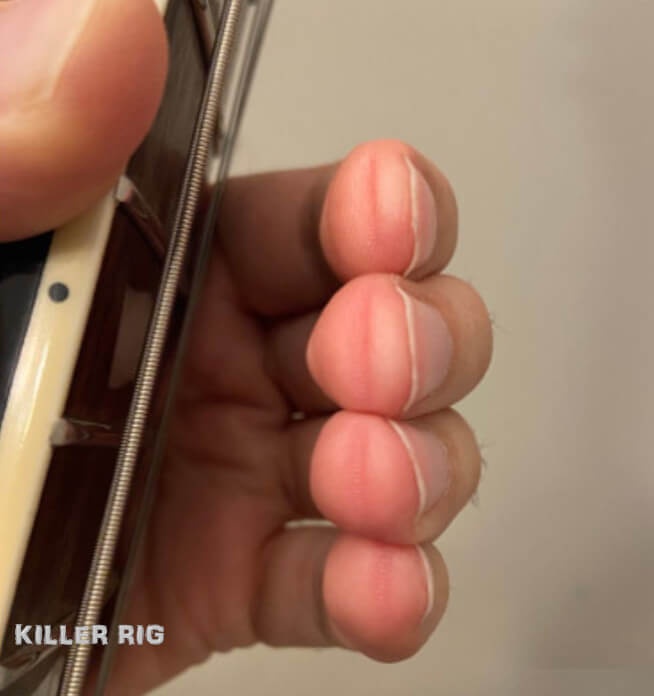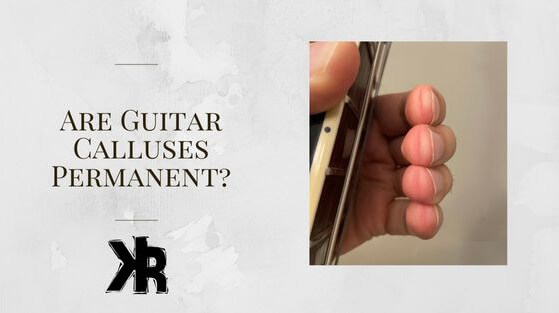Table of Contents
As guitar players, one of the things we will never forget is the fingertip pain that came along with the hobby.
Those first few days of throbbing fingers could not go away soon enough. Once the calluses began to form, things got much easier. But are guitar calluses permanent?
Guitar calluses will go away over time. They are not permanent and if you stop playing guitar for a long period, your fingertips will soften. It’s estimated that after 1-2 months your calluses will have gone away completely.
If you are done with the guitar, you may want to speed up the process. Or perhaps you want to maintain your calluses as you just can’t find time to play right now. Whatever it is, we will be touching on guitar calluses in this Killer Rig article.
Guitar Playing and Calluses
Calluses are your body’s way of protecting itself. Especially from constant pressure and friction from the strings rubbing against your fingertips.
This will cause your body to produce more skin cells to protect the area. The new cells will be tougher and thicker than the surrounding skin, forming a callus.
When you first begin playing the strings on a guitar, your fingertips will form blisters. This is because the pressure is too great for your skin. This can be sore and painful for the first little while as your body begins to adapt.
As the blisters begin to heal, and the repetition of continual playing. Calluses begin to continue to get harder until there is no more discomfort. You are then left with guitar calluses on your fingertips.
Can You Speed up Guitar Callus Formation?
There is no real way to speed up the process. Your body will produce more skin cells when it’s necessary. You can, however, help things along a little by using products that dry your skin.
Rubbing alcohol can help to dry the skin and make it harder. This will then help the callus to form more quickly. Be careful not to overdo it, though, as you don’t want to damage your skin. And do your best not to break open the skin once blistered.
Apart from this, just make sure that you are playing guitar regularly. It will be painful for a while and so make sure to take breaks. To reduce the pain, you can also try:
- Using lighter gauge strings
- Keep your nails short
- Don’t press down too hard
- Try wearing a tight rubber glove
Are Guitar Calluses Bad?
Calluses that develop from playing the guitar are not bad. In fact, they are necessary if you plan on playing without experiencing pain each time you do.
Without calluses, your fingers would be sore or blistered all the time. This would make it impossible to play the guitar.
It’s your body’s natural way of protecting sensitive areas from pressure and friction. There is no harm if calluses develop from playing guitar. Like anything, you will eventually get used to the fact that they are there.
As you improve your technique, you will start to appreciate them more and find ways to take care of them.
Are Guitar Calluses Permanent?
Guitar calluses are not permanent. If you stop playing for a while, your calluses will gradually disappear. It’s estimated that it takes around 1-2 months for them to completely go away.
If you don’t quit playing guitar completely, the calluses will remain. But they will soften over time. What if you are not looking to remove them? Then it’s a good idea to continue to press your fingertips on something like a string.
Some people use a credit card edge and periodically apply pressure to the calluses. This can help to keep them thick and prevent softening.

Getting Rid Of My Calluses Sooner
If you want to get rid of your guitar calluses sooner, there are a few things you can do. You can use a pumice stone to gently rub away the dead skin cells. Be sure not to be too rough, though, as you don’t want to damage your skin.
You can also try using products that contain lactic acid or urea. These are found in moisturizers and can help to soften the calluses. Once they are softened, you can then use the pumice stone to rub them away.
Otherwise, it’s best to wait until they go away on their own. Most people don’t notice them as they gradually fade back to soft skin.
Taking Care of Calluses
If you want to maintain your guitar calluses, there are a few things you can do. Use a good quality hand cream to keep your skin moisturized. This will help to prevent the calluses from getting too dry, peeling, or cracking.
One of the bigger issues with guitar calluses is that they peel when you play a lot. Moisturizing them can help prevent that and keep your skin looking healthy. Which also might be important to you.
It’s also a good idea to not play guitar when your fingertips are wet. With weakened calluses due to water soaking, there is a good chance that the skin can break, and they could peel off.
And finally, keep your guitar strings clean and well-maintained. Don’t play strings that have rust on them or are too dirty. This can hurt your calluses and fingertips for that matter.
Conclusion
To play like Jimi Hendrix, you just gotta have the calluses. So push through the pain and develop them, just treat your fingertips well and don’t break open the skin. Before you know it, you will have some tough fingertips ready to play for hours!
What if, you need to take a long break from the guitar? Then try to keep them tough by applying pressure to them similarly to strings. This way, when you come back to the instrument, you will still have good guitar calluses.
FAQs
How long do guitar calluses last?
If you continue to play the guitar regularly, your calluses will last until you stop. If you are inactive for 4-8 weeks, you will find that the calluses will soften. They may completely go away after this period.
Is it good to have guitar calluses?
Yes, guitar calluses are necessary to play the instrument on any level. Without them, the pain from your fingertips will limit your abilities as a guitarist. It’s best to try and work on developing calluses as soon as possible to be able to advance with the instrument.
Are guitar calluses noticeable?
Yes, guitar calluses can be noticeable. But this depends on how well you maintain them. If you let them dry out, they may peel and crack, which can be most noticeable.
If they are well-kept and moisturized, they are not unsightly and should not cause any concern.

